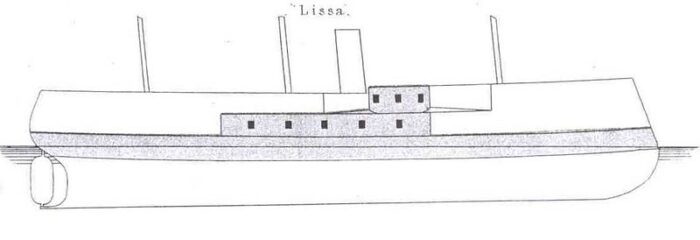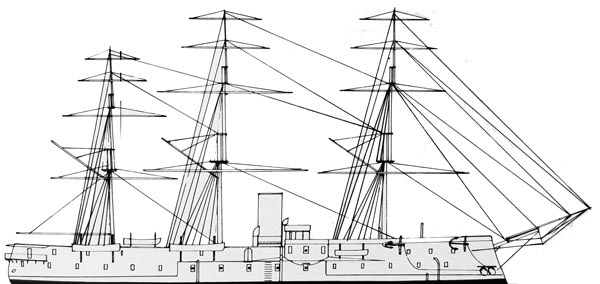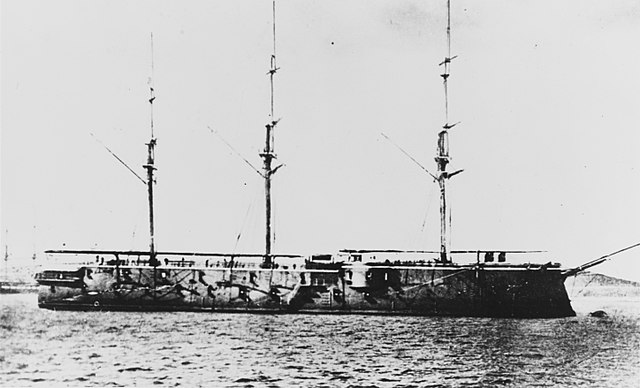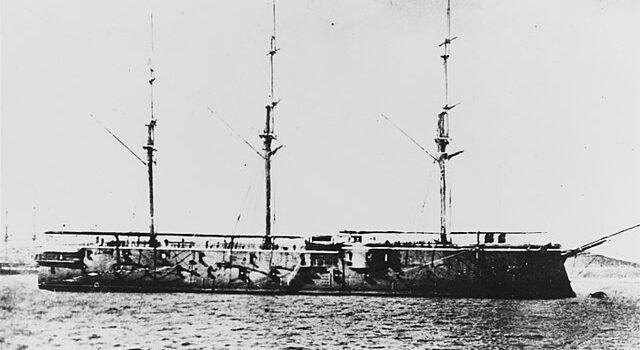 Austro-Hungarian Navy central battery ironclad (1871-1892)
Austro-Hungarian Navy central battery ironclad (1871-1892)
We start a new cycle dedicated to the Austro-Hungarian Navy until 1900 (the topic of WWI was seen in detail), covering the present Lissa (1869), Custoza (1872), Erzherzog Albrecht (1872), but not SMS Kaiser (already seen). We will see also the Kaiser Max class (1875), SMS Tegetthoff (1878) and the Kronprinzessin Erzh. Stephanie and Rudolf barbette ships. SMS Lissa, named after the Battle was an ironclad warship started in 1867, the only one in her class and only one voted in the new Empire. She was the also the first casemate ship of the Austro-Hungarian navy, boasting a main battery of twelve 9-inch (229 mm) guns in casemate, and was completed by May 1871, much delayed to budgetary tractation with the Hungarian part of the parliament. This lack of funding went on in her career and she never was really active, being laid up in Pola in semi-reserve, having a 1880–1881 modernization until stricken from the fleet in 1892.
Design of the class
Hull and general design
Lissa measured 86.76 meters (284 ft 8 in) long at the waterline, 89.38 m (293 ft 3 in) overall for a beam of 17.32 m (56 ft 10 in) and mean draft of 8.5 m (27 ft 11 in) which was fairly deep not only for Austrian standards, for the adriatic, or even for ironclads in general. This made her both more stable but also sluggish. She was also the largest ironclad ever built for the Navy at 7,086 long tons (7,200 t), compared to 5,130t for the Erzh. F. Max class (1865). Quite a symbolic curve as the previous kaiser Max (1862) were 3,590t and the Salamander of 1861, 2,750t.
As per design, the hull had a moderate ram bow, less curvy than on the Erzh. Ferdinand Max class, and a different poop, no longer “clipper” style with a balcony. She carried three anchors.
As for construction, she still used timber as her hull and most of the upper works and of course the casemate, had a wooden structure on which iron plating was attached. However the sides of the casemate was made of a harder iron. The rear deck had no protection but simple rope barriers, whereas the forward section (flush deck all along) was bulwarked for better seaworthiness. She was also fully masted, with a single funnel relatively tall for the time, on which was added a bridge, but no conning tower. She was three-masted, barque rigged, with four levels of sail and possibly steam-driven capstans.
The crew comprised 620 officers and enlisted men. She also had nice or more service boats, six of them being under davits amidship and rear. The peculiar shape of her central casemate had two stages, one lower battery with fixed ports but rail-mounted guns and a superior, sponsoned casemate with three ports, for a gun with greater fire angles, and recesses fore and aft at this level. She was also the last ironclad with that mixed configuration, and last with a four-stage barque rig. Next Cutoza and Erzh. Albrecth would have schooner rig and full casemated battery.
Protection

She had a mixed protection with a classic full armored belt made of wrought iron plate, 152 mm (6 in) thick, and backed with 770 mm (30.3 in) of timber, mostly teak. This belt extended down 1.74 m (5 ft 9 in) below the waterline. The main battery casemate was protected by 127 mm (5 in) of iron plating backed with 724 mm (28.5 in) of timber and there were transverse bulkheads on either end of it, 114 mm (4.5 in) thick to foil cross-fire. She had no conning tower. SMS Tegetthof was the first to have one.
Powerplant
Her propulsion comprised a single-expansion horizontal steam engine with 2-cylinder, driving a single screw propeller four bladed oi bronze and 6.62 m (21.7 ft) in diameter, which was the largest size of any propeller in the Austrian Navy ever. Steam was provided by seven boilers fitted wth a total of with thirty fireboxes, trunked all into a single funnel amidships. This powerplant produced more than any Austrian ship to date, 3,619 indicated horsepower (2,699 kW) versus 2925 ihp on the Erzh.F.Max.
This enabled a top speed of 12.83 knots (23.76 km/h; 14.76 mph). However on speed trials on 9 May 1871 she did much better at 13.29 knots (24.61 km/h; 15.29 mph) based on 3,663 ihp (2,731 kW) in forced heat. At this speed she could still reach 1,420 nautical miles (2,630 km; 1,630 mi) based on her generous coal supply, courtesy of a deep, roomy hull. To compare the Erzh.F.Max had a 7.14 meters (23ft 5in) draft. Her full ship rig was the largest and tallest of the time for an Adriatic ironclad, at 3,112 square meters (33,500 sq ft). In 1886, it was cut down to 1,404 m2 (15,110 sq ft) as she was modernized, and her powerplant modified.
Armament
Lissa’s main battery comprised twelve 9-inch (229 mm) breech-loading guns, all provided by Krupp at its Essen Works. Ten were placed in the central armored battery on the broadside only with low gun ports at 1.96 m (6 ft 5 in) from waterline, which needed to be closed and proofed in heavy weather. The remaining two guns were in the smaller redoubt above, sponsons and thus, partly hanging over the lower casemate and providing a true 180° fire arc unlike the lower guns. All these could still penetrate 264 mm (10.4 in) of iron armor. This was completed by smaller guns: Four 8-pounder muzzle-loading rifled (MLR) guns, two 3-pounder MLR guns placed behind upper battery gun ports and on deck for the latter. Exact position is unknown.

⚙ specs. |
|
| Displacement | 7,086 long tons (7,200 t) |
| Dimensions | 89.38 x 17.32 x 8.5m (293 ft 3 in x 56 ft 10 in x 27 ft 11 in) |
| Propulsion | One shaft prop., marine steam engine, 7 boilers 3,619 ihp (2,699 kW) |
| Speed | 12.83 knots (23.76 km/h; 14.76 mph) |
| Range | 1,420 nautical miles (2,630 km; 1,630 mi) |
| Armament | 12× 9-inch (229 mm) gun, 4× 8-pdr guns, 3× 3-pdr guns |
| Protection | Belt 152 mm (6 in), Casemate 127 mm (5 in), Bulkheads 114 mm (4.5 in) |
| Crew | 620 |
Career of SMS Lissa
SMS Lissa was laid down on 27 June 1867 at Stabilimento Tecnico Triestino (STT) in San Marco, launched on 25 February 1869 and fitted-out work, visited by Kaiser Franz Joseph I in 1870. Completion of the ship was delayed due to budget interruptions. Hungarian delegated indeed blocked the provision of British made armor plating. She was eventually completed a yard behind schedule on May 1871. The Hungarian half of the Dual Monarchy continued yearly to starve the naval budget naval budget, making the fleet a virtual reserve one in peacetime with past-time sailors having other jobs most of the year and rare refreshing training sorties. Skeleton crews watched over maintennace, and even it was not optimal.
After the famous fleet commander Wilhelm von Tegetthoff died in 1871, budgetary problems only went worse. His successor, Friedrich von Pöck did not succeed, but still managed to obtain the reconstruction of the 1859 steam ship of the line kaiser as a second central citadel ironclad and the reconstruction anew of two of the old Kaiser Max class later in 1873. Both spent their time anchored in Pola, laid up in reserve. Only cheaper to operate frigates multipled voyages in the 1870s.

Lissa still saw exercises with the active squadron in November 1871 instead of SMS Habsburg as flagship. She was commanded by Konteradmiral Alois von Pokorny. Lissa sailed with both Erz. F. max ironclads, and the screw corvettes Zrinyi, Dandolo, gunboat Hum for a training cruise in the Adriatic. Lissa remained flagship in 1872, now enriched by the arrival of the screw frigate Novara and by 15 January 1872, the squadron sailed for the Dalmatian islands for manoeuvers. Zrinyi was sent to the Levant by late February while Lissa was sent to Smyrna (Ottoman Empire) on 1 March, joined by Novara and by late Larch by Zrinyi for patrols in the Greek and Ottoman islands, protecting Austrian citizens from troubles.
They left the area by mid-July for tactical training off Corfu, visited Messinan Sicily on 21-29 July, then Palermo on 3 August. They stayed there until 12 August as Lissa needed her engines repaired. Next, they sailed for Goletta in Tunisia and held celebrations for the Kaiser’s birthday leaving on 23 August for Corfu (28th) and Lissa-Novara proceeded together to Smyrna, and assisted the capsized Italian brigantine Providenza. Lissa had a serious fire in the night of 3–4 September 1872 whiled anchored off Corfu, near the propellant magazine. The present crew managed to extinguish it before the worst could happen but the fire was only put out after two hours. Still, damage was relative. The squadron was reunited on 10 September for a cruise in the eastern Mediterranean and stopped on the 19th in Larnaca (Cyprus), Agria 27th and Smyrna on the 29th. By early October they were ordered back to Pola and by early December placed in reserve.
Lissa stayed the fleet’s flagship, active squadron for 1873 with the corvettes Zrinyi, Fasana and gunboat Velebich. She would return to Smyrna, the corvettes being dispatched in Greece and Spain. On 24 September they were reunited at Port Said to recoal and for shooting practice. Lissa returned and stayed off Smyrna until 3 November, then cruised off Syria and ended in Souda Bay, Crete to recoal. She played the host for a small Ottoman squadron later when sailing to Piraeus on 18 November for the King and Queen of Greece. Next she returned to Syria and Smyrna and was present later at Malta for the 25th anniversary of the reign of Franz Joseph, greeted by the Russian ironclad Kniaz Pozharsky. Next she was in Corfu and then Trieste for more shooting practice and back in Pola by December, removed from the active squadron, disarmed, placed in reserve until 1875.
They year she received new boilers and saw her rigging cut down and modified. In 1880 examination of her wooden hull show it had badly rotten. She was drydocked in Pola Arsenal, her armor plating removed, her deteriorated timber replaced anew and her twelve 9-inch guns were retained but as light batteru she gained four 9 cm (3.5 in)/24 and two 7 cm (2.8 in)/15 Krupp as well as three 47 mm (1.9 in) Hotchkiss guns and two 25 mm (0.98 in) Nordenfelt MGs. She returned in the active squadron in 1882, took part in fleet exercises of June 1885 as flagship. The squadron trained around the island of Lissa. She was in semi-reserve, keeping her status until 1888, then placed in II Reserve and further modified: Torpedo launchers were added in 1885 and her main battery guns were renewed with new models, quick firing, same caliber from Krupp. Despite of this she saw little activity until decommissioned and stricken on 13 November 1892, sold and BU between 1893 and 1895.
Read More/Src
Books
von Benko, Jerolim Freiherrn, ed. (1873). “Bewegungen S. M. Kriegsschiffe vom September 1871 bis September 1872” Carl Gerold’s Sohn.
“Bewegungen S. M. Kriegsschiffe vom 1. September 1873 bis 31. August 1874” Pola: Verlag der Redaction.
Brassey, Thomas, ed. (1886). “Exercises of the Austrian Fleet. 1885”. The Naval Annual. J. Griffin & Co.
Pawlik, Georg (2003). Des Kaisers Schwimmende Festungen: die Kasemattschiffe Österreich-Ungarns. Neuer Wissenschaftlicher Verlag.
Scheltema de Heere, R. F. (1973). Fisher, Edward C. (ed.). “Austro-Hungarian Battleships”. Warship International. X (1). Naval Records Club, Inc.
Sieche, Erwin & Bilzer, Ferdinand (1979). “Austria-Hungary”. Gardiner, Robert; Chesneau, Roger & Kolesnik, Eugene M. Conway’s All the World’s Fighting Ships 1860–1905.
Sondhaus, Lawrence (1994). The Naval Policy of Austria-Hungary, 1867–1918. Purdue University Press.
Links
shipstamps.co.uk/
weaponsandwarfare.com
en.wikipedia.org SMS_Lissa


 Latest Facebook Entry -
Latest Facebook Entry -  X(Tweeter) Naval Encyclopedia's deck archive
X(Tweeter) Naval Encyclopedia's deck archive Instagram (@navalencyc)
Instagram (@navalencyc)





 French Navy
French Navy Royal Navy
Royal Navy Russian Navy
Russian Navy Armada Espanola
Armada Espanola Austrian Navy
Austrian Navy K.u.K. Kriegsmarine
K.u.K. Kriegsmarine Dansk Marine
Dansk Marine Nautiko Hellenon
Nautiko Hellenon Koninklije Marine 1870
Koninklije Marine 1870 Marinha do Brasil
Marinha do Brasil Osmanlı Donanması
Osmanlı Donanması Marina Do Peru
Marina Do Peru Marinha do Portugal
Marinha do Portugal Regia Marina 1870
Regia Marina 1870 Nihhon Kaigun 1870
Nihhon Kaigun 1870 Preußische Marine 1870
Preußische Marine 1870 Russkiy Flot 1870
Russkiy Flot 1870 Svenska marinen
Svenska marinen Søværnet
Søværnet Union Navy
Union Navy Confederate Navy
Confederate Navy Armada de Argentina
Armada de Argentina Imperial Chinese Navy
Imperial Chinese Navy Marinha do Portugal
Marinha do Portugal Mexico
Mexico Kaiserliche Marine
Kaiserliche Marine 1898 US Navy
1898 US Navy Sovietskiy Flot
Sovietskiy Flot Royal Canadian Navy
Royal Canadian Navy Royal Australian Navy
Royal Australian Navy RNZN Fleet
RNZN Fleet Chinese Navy 1937
Chinese Navy 1937 Kriegsmarine
Kriegsmarine Chilean Navy
Chilean Navy Danish Navy
Danish Navy Finnish Navy
Finnish Navy Hellenic Navy
Hellenic Navy Polish Navy
Polish Navy Romanian Navy
Romanian Navy Turkish Navy
Turkish Navy Royal Yugoslav Navy
Royal Yugoslav Navy Royal Thai Navy
Royal Thai Navy Minor Navies
Minor Navies Albania
Albania Austria
Austria Belgium
Belgium Columbia
Columbia Costa Rica
Costa Rica Cuba
Cuba Czechoslovakia
Czechoslovakia Dominican Republic
Dominican Republic Haiti
Haiti Hungary
Hungary Honduras
Honduras Estonia
Estonia Iceland
Iceland Eire
Eire Equador
Equador Iran
Iran Iraq
Iraq Latvia
Latvia Liberia
Liberia Lithuania
Lithuania Mandchukuo
Mandchukuo Morocco
Morocco Nicaragua
Nicaragua Persia
Persia San Salvador
San Salvador Sarawak
Sarawak Uruguay
Uruguay Venezuela
Venezuela Zanzibar
Zanzibar Warsaw Pact Navies
Warsaw Pact Navies Bulgaria
Bulgaria Hungary
Hungary

 Bundesmarine
Bundesmarine Dutch Navy
Dutch Navy Hellenic Navy
Hellenic Navy Marina Militare
Marina Militare Yugoslav Navy
Yugoslav Navy Chinese Navy
Chinese Navy Indian Navy
Indian Navy Indonesian Navy
Indonesian Navy JMSDF
JMSDF North Korean Navy
North Korean Navy Pakistani Navy
Pakistani Navy Philippines Navy
Philippines Navy ROKN
ROKN Rep. of Singapore Navy
Rep. of Singapore Navy Taiwanese Navy
Taiwanese Navy IDF Navy
IDF Navy Saudi Navy
Saudi Navy Royal New Zealand Navy
Royal New Zealand Navy Egyptian Navy
Egyptian Navy South African Navy
South African Navy






























 Ukrainian Navy
Ukrainian Navy dbodesign
dbodesign